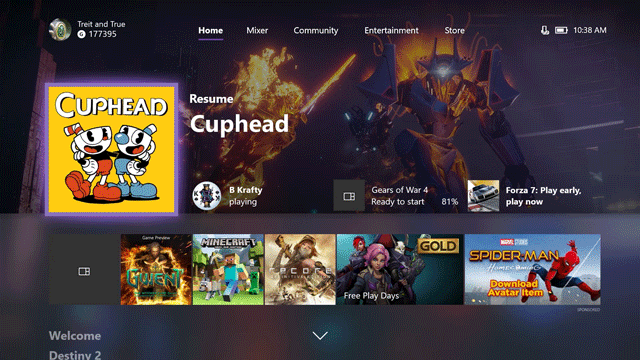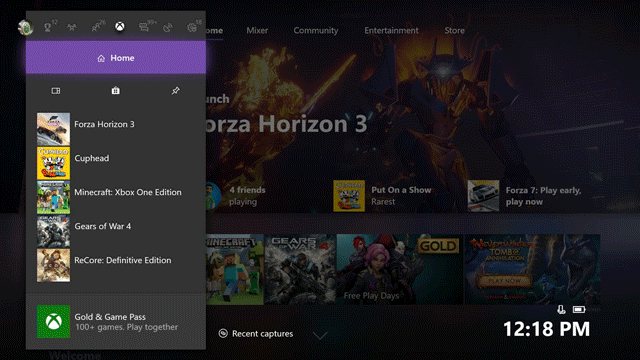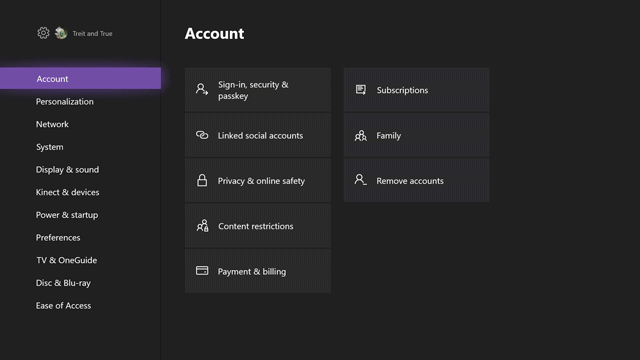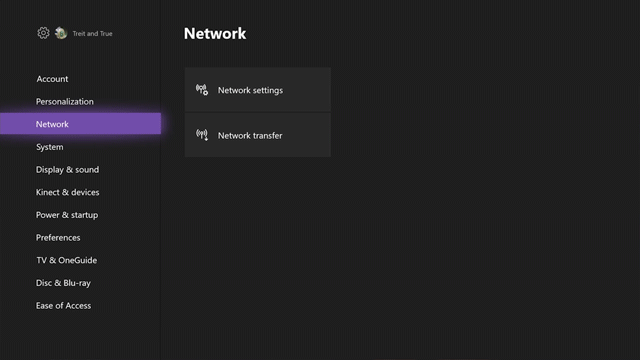The Xbox One X Review: Putting A Spotlight On Gaming
by Brett Howse on November 3, 2017 3:01 AM EST- Posted in
- Consoles
- Microsoft
- Xbox One
- Xbox
- Xbox One X
User Interface
The User Interface (UI) for the Xbox One X is exactly the same as the original console, thanks to the shared platform underneath. In mid October, Microsoft released the Xbox One Fall Update, which made further changes to the UI. As with the Xbox 360, Microsoft is not content to leave the UI alone, but instead they are always trying to improve it. Whether they’ve succeeded in improving it is not always a clear cut answer, but after using the Fall Update for a few weeks, it is an overall nice update. Let’s go over some of the highlights and features.
The new Home screen offers a lot more selections without having to switch screens, but it’s nice to see the Games and Apps very quickly available. You can now pin games to Home, and they get their own home page directly below the main Home page. This does make it harder to get to your pins though, especially if you’ve pinned a couple of games to Home, since you have to scroll past them, so it is really only useful for the one or two games you are playing right now. Others may disagree of course.
What has improved a lot though is the Guide, which is the overlay from the left which pops up when you hit home. Here it’s very easy to get to pins, all games and apps, and your most recent apps, but it’s also easier to sign out, get to settings, or find your game captures. The Guide performance seems like they’ve finally got it where they want it, although the extra performance of the X likely helps a lot in this regard.
The new light theme is a nice touch for those that get tired of the standard dark theme, although the dark theme looks amazing on OLED.
Microsoft has added some features to the Fall Update specifically to get you set up for the Xbox One X upgrade too, which are worth discussing. First, you can backup your games, and your console settings, to a USB hard drive, to make it easy to transfer them to your new console. Or, if you are still going to have both consoles up and running, there’s also a new Network Transfer feature which lets you pull games from one Xbox where they are already downloaded, to the other. Since most people have a much faster network than internet connection, this is a great feature, even though we only saw about 300 Mbps maximum from it even over a wired gigabit Ethernet connection to both consoles. You can select some, or just transfer all of your games.
What would make this feature even better is if it would automatically do this for the user, much like the Branch Cache features of Windows, or even the new Windows Update functionality in Windows 10 where it can pull updates from another machine on the LAN. The method to do this currently is to go into settings, then network, and then start a network transfer, but this isn’t very obvious, and if the system would just pull the data from the other system when you select it in your “Ready to Install” list, that would make it easier.
In addition to the network transfer, if you have an Xbox One, and are upgrading to an Xbox One X, you can also set your Xbox One to download the 4K assets for games that are Xbox One Enhanced, but, like the Network Transfer feature, this is also buried in settings, and not obvious. You have to go to Settings, System, and then Backup & transfer, then check the box that says Download 4K game content. It’s nice to have, but it’s just not obvious to most users, and you pretty much have to know about it ahead of time to even know to look for it. If you are getting an Xbox One X, and you have an earlier model, it’s definitely worth your time though, since the 4K updates can be massive. The update for Gears of War 4 was something like 26 GB, making the game over 90 GB total.
Game DVR also got an update to allow 4K recordings up to 30 seconds max, and the system will automatically convert the videos to SDR for sharing, which is a nice touch. As we saw earlier in the 4K screenshots, they are just presented as PNG files with the HDR info stripped away, resulting in the wrong colors being displayed. It’s hopeful this will get fixed in the future.
The only downside with the UI is that it, once again, changed somewhat dramatically, meaning muscle memory may have to be re-learned. That’s not always ideal, but in this case, it does seem like the overall experience is better than before.














128 Comments
View All Comments
Lolimaster - Sunday, November 5, 2017 - link
Not Vega. Navi + Zen3 cores @7nm+ (probably a 6cores/12threads APU).Rufnek - Monday, November 6, 2017 - link
*cough*.Try to keep in mind they have to plan the consoles 3-5 years in advance. The next consoles will likely be a low power Ryzen (v1.5+) with a low power Vega (v1.5+). The .5 is for low power, smaller circuit refresh, the + is for specialized items in the CPU/GPU.
Hixbot - Friday, November 3, 2017 - link
I'm also disappointed with the CPU on Xbox One X. In my opinion the biggest flaw with PS4 and Xbox One is the CPU performance. A developer needs to sacrifice alot to hit 60fps, because of the poor CPUIf Xbox One X leveraged a Ryzen based APU, it would have been a 100% CPU performance increase, which would have been enough to push games that were CPU limited to 30fps to 60fps.
The 30% CPU overclock on the Xbox One X will not be enough to boost 30fps games to 60fps.
Frankly the massive GPU upgrade will allow much higher resolutions, in which is something I'm not really interested, but will not allow better framerates on CPU limited games, which is much more important to me.
InlineV - Friday, November 3, 2017 - link
It is worth noting that DirectX draw calls are no longer CPU bound. That function has been integrated, at the hardware level, into the GPU. That mitigates a potential bottleneck. Arguably, it is one of the most interesting innovations in the One X. It may never make it into commodity PC hardware but it would be significant if it did.dogen1 - Friday, November 3, 2017 - link
Technically the Xbox one already had this feature, or part of the same feature built into the GPU command processor.tipoo - Friday, November 3, 2017 - link
The article says it's still split with the GPU command processor and the CPU, but that the more powerful CP this time allows more functions to move to it.Alexvrb - Friday, November 3, 2017 - link
The CPU isn't going to hold it back in gaming. Also, this custom SoC was in development for some time before they ever started cranking them out. Redesigning it for Zen cores would have delayed it until sometime next year... and for what? More CPU horsepower isn't going to magically net them 60 FPS in gaming scenarios which are largely GPU-bound. Plus it would further complicate backwards compat (frankly I was shocked the lack of eSRAM didn't hurt them more in that department).Can't wait to see an in-depth look at all the interesting little custom bits. See InlineV's post. I want to read more about additions like that.
franzeal - Friday, November 3, 2017 - link
You'd be wrong. There are plenty of games (Assassin's Creed Unity a glaring example):https://www.youtube.com/watch?v=ZJmWsgFl6kA
StevoLincolnite - Saturday, November 4, 2017 - link
Digital Foundry has done a good game breakdown already. The CPU most certainly is a hindrance.Rufnek - Monday, November 6, 2017 - link
Digital Foundry reads like a fluff piece. Very disappointed as I tend to lean on their technical reviews.Want an actual review of good & bad and questions still unanswered... then read this.
https://arstechnica.com/gaming/2017/11/xbox-one-x-...